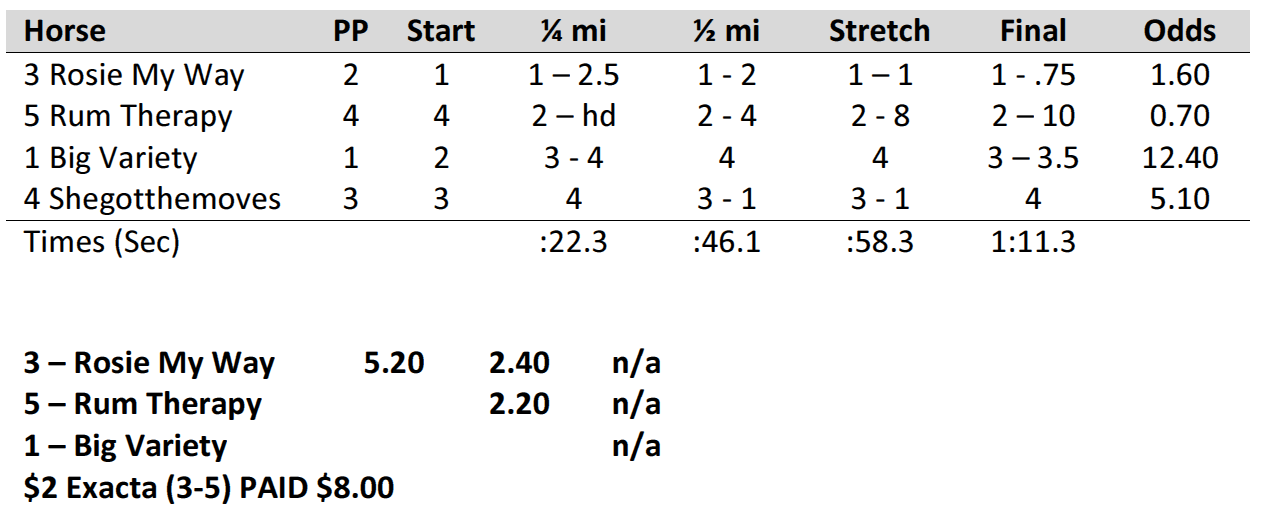One of the race-day situations that I dread the most is, after having done all of my handicapping for a particular card, finding out that there are a number of scratches in the races I felt best about. Many horseplayers I encounter at the track mistakenly just eliminate the scratched horses from the contenders of their proposed wagers without giving the race a second thought. While some of these scratches will not affect my analysis of the race, other scratches may completely change how the probable pace scenario will shape up — which will also change my betting strategy for the race.
Scratches fall into three categories:
- No-Impact Scratches
- Early-Pace-Impact Scratches
- Eliminating a Weak Early Pace
- Eliminating a Strong Early Pace
- Late-Pace-Impact Scratches
Today, we will look at “No-Impact Scratches” and “Early-Pace-Impact Scratches: Eliminating a Weak Early Pace.” In second installment of this series, I will discuss “Early-Pace-Impact Scratches: Eliminating a Strong Early Pace” and, in third and final installment of this series, I will discuss “Late-Pace-Impact Scratches.”
 No-Impact Scratches
No-Impact Scratches
This is the situation that we all cross our fingers for when we see the changes posted for today’s races. We hope that the scratches will have no impact on the probable pace scenario. In this case, none of the horses that you have figured to be on or impact the early lead — neither strong early speed horses or weak early speed horses — have been scratched; nor have any of the horses you expect to stalk, or rally from off the pace to win with a late run, have been scratched.
This requires no reevaluation of today’s pace scenario.
Early-Pace-Impact Scratches: Eliminating a Weak Early Pace
This is when either a “habitual quitter” or a “one-dimensional frontrunner” is scratched that eliminates their negative impact on the early pace for other one-dimensional frontrunners in the field. If the scratch results in leaving only one true one-dimensional frontrunner in the field that has a pace advantage over the other entries, they will be able to get an uncontested early lead and be able to win without any pressure.
(To further understand the terms “habitual quitters” and “one-dimensional frontrunners,” please refer to my article Weak Early Speed from March 11, 2016.)
The following example illustrates how I had to reevaluate the pace of the first race at Parx on a sloppy Tuesday, March 15, 2016:

Big Variety turns back after two routes, but showed nothing much in the two sprints she ran in October and hasn’t shown much life since last June. She likely won’t figure on today’s pace at all; however, if she does, it will only be a weak effort to the first quarter and probably not enough to disrupt how the race will set up.

Cat McGinley showed some early speed in her last race at this level and backed up quickly with some early pressure. Two races back, at Penn National, she faced a much faster pace than she can handle and was again spent early and faded. Looking further down her past performances, she has faltered against tougher fields than today’s with a wire-to-wire effort in a much slower pace than is anticipated here back in November. She looks to be on or close to the lead, but will falter with being forced to run faster than she is comfortable. Her most recent efforts make her a one-dimensional frontrunner.

Rosie My Way has shown solid recent form in both of her last two claiming races that are not considered in today’s eligibility and meets one of the conditions that was set out last week in my article The Devil is in the Details: Finding an Edge in Conditioned Claiming Races. Her last race looks deceptively good since the late pace was completely nonexistent, enabling her to maintain a one-length lead through the stretch. On Dec. 15, she coasted wire to wire on an uncontested early lead against very slow fractions (opening half-mile in :48.4). Prior to that start, she had a long layoff after a troubled trip (clipped heels) at Delaware following a poor effort at Parx on May 23, and folding in a duel at this level on May 11. While she has shown the ability to duel against lower-level horses, she is more of a one-dimensional frontrunner at this level.

Shesgotthemoves steps up in class off of the claim and showed life in her first race back off of a short layoff. She will take advantage of a duel on the front end by making a big late run when the pace breaks down. She has a pretty solid history of good, late efforts — with the exception of her Nov. 1 race, in which she was outclassed. She figures to be close to the front late.

Rum Therapy’s best running lines to review are from Nov. 14 and Oct. 11, since we can toss her last start with the bobbled break and her third race back on Oct. 28 in the mud. She figures to be closer to the pace, but more likely stalking than pressing. A duel on the front end would set her up for a nice late run. Rum Therapy’s record in 2015 isn’t encouraging, but she has been running against higher-class horses, over the grass, and over the Polytrack.

Jennie Says So is more of a true presser than Rum Therapy, meaning that she will likely be closer to the pace as it unfolds (within about two lengths). The atypical race in her recent running lines is two back at Penn on Jan. 13 where she faced a considerably faster pace than normal and was within one length at the second call. Looking at the balance of her running lines reveals that she will need a somewhat slower pace than is anticipated here to be a factor or she will need to stalk and come from well off the pace late.
Initial Pick(s): 5-Rum Therapy & 4-Shegotthemoves
Initial Pace Analysis: Weak Early Speed
2-Cat McGinley and 3-Rosie My Way will both vie for the early lead. Since both horses are one-dimensional frontrunners, they figure to run each other out by the stretch call. 4-Shegotthemoves and 5-Rum Therapy both figure to start making their moves as the two frontrunners tire and will ultimately prevail. 6-Jennie Says So is at a disadvantage given the likely fractions, but could be making a late run that could get her into a trifecta. The probable second call time on this race should be between 46.3 and 46.4 seconds.
Scratches: 2-Cat McGinley and 6-Jennie Says So.
Revised Pick(s): 3-Rosie My Way
Revised Pace Analysis: Strong Early Speed
With the scratch of one of the two one-dimensional frontrunners, we are left with one horse that has early speed and, now, a sizable pace advantage over the balance of this short field, 3-Rosie My Way. 1-Big Variety wasn’t likely to be a factor before and the same remains true now. Both 4-Shegotthemoves and 5-Rum Therapy aren’t likely to apply any pressure to “Rosie,” who now figures to get an uncontested lead.
The scratch of 2-Cat McGinley, sets this race up for a wire-to-wire run by Rosie My Way… which is exactly how the race played out:

Rosie My Way ran her half mile at a slightly better pace than I had originally predicted (:46.1 actual versus :46.3 predicted) and had only shown two prior efforts over this track with better times than that while chasing the leader before folding. However, the scratch of the second one-dimensional frontrunner gave her the cushion she needed to get on the engine and hold off the late run of Rum Therapy.
Scratches may have impacts that are not immediately apparent unless the race’s pace scenario is reevaluated based on those changes. By taking a second look, you will be more confident in your original play, make an alternate selection, or find that the race is no longer playable.
But you will give yourself a better chance to win and an edge over bettors who do not reevaluate.




